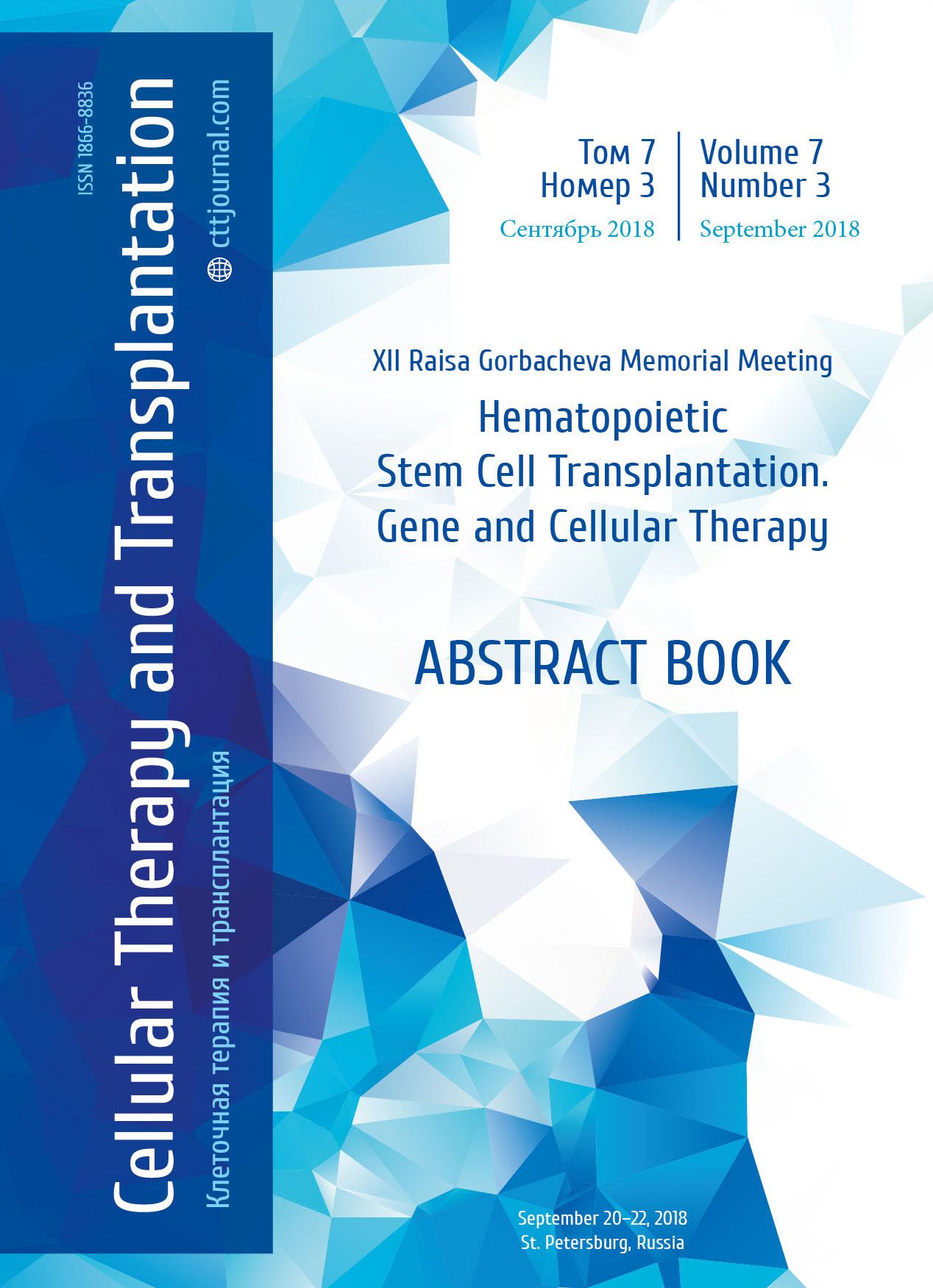Experience with hypomethylating drug application in allogeneic hematopoietic stem cell transplantation
Summary
Introduction
Allogeneic hematopoietic stem cell transplantation (allo-HSCT) is an effective treatment method in patients with high-risk acute myeloid leukemia (AML). Nevertheless, disease relapse develops in 40-70% of patients during the first posttransplant year, and achievement of repeated remissions is possible only in 15-30% of patients. Hypomethylating, or epigenetic therapy (HM) appears to be a promising approach to these patients. The mechanism of HM drug action includes their ability to increase the levels of regulatory T-cells (Тregs, CD4+CD25+FOXP3+), which play a key role in the development of immunological tolerance in the post-transplant period, reducing the degree of development and severity of “graft-versus-host disease” (GVHD). In addition, the stimulating effect of these drugs on the pool of cytotoxic CD8+T-lymphocytes provides implementation of a tumor-specific response in the graft-versus-leukemia (GVL) effect.
Aim
Objective of this study was to evaluate the results of the azacitidine application after allo-HSCT in patients with AML.
Patients and methods
Twenty patients with AML were transplanted between 2015 and 2018 at the Federal State Institute of Science “Kirov Research Institute of Hematology and Blood Transfusion of the Federal Medical and Biological Agency of Russia” including 18 adult patients (14 women and 4 men) and 2 children. Myeloablative conditioning was used in 5 (25%) cases. In 15 (75%) patients, the reduced intensity regimen was applied. Related allo-HSCT was performed in 15 (75%) patients, 4 of them were transplanted from HLA-haploidentical donors. Unrelated allo-HSCT was carried out from fully matched donors in 5 cases. Out of 20 patients, 9 (45%) patients were alive at the time of evaluation. Eleven (55%) patients died at different times after alloHSCT due to severe infectious complications, severe acute GVHD, thrombotic microangiopathy, early relapse of the disease. Preventive azacitidine courses were given to 7 patients with high-risk AML. Of these, 6 women and 1 man, with a median age of 36.7 years (range: 20-50 years). Azacitidine therapy was started after hematopoietic recovery on the average at day +85 (range: 40-121 days) in the absence of severe infectious and other complications. The drug was administered according to the scheme: 35 mg/m2 subcutaneously for 5-7 days, every 28 days, with a median of 8 courses. In 3 cases, azacitidine was combined with donor lymphocyte infusions (DLI).
Results
All the patients who received azacitidine at the time of the study are alive. Six of them have a disease remission. Prior to the azacitidine administration, 2 patients had complete donor hematopoiesis, in 1 complete donor chimerism was achieved in 2 months of therapy, in 4 there was a mixed donor chimerism. In 1 of them, a late relapse occurred after 3 courses of azacitidine, and now he receives antirelapse chemotherapy (ChT).
Clinical case
Patient T., female, 22 years old, AML, t(8;21), complete remission-3, unrelated allo-HSCT was performed in March 2016. The interval from treatment initiation to allo-HSCT was 27 months. The azacitidine prophylactic administration was started at day +56 after allo-HSCT at a dose of 35mg/m2 every 5 days of the 28-day cycle, for up to 6 cycles, and the therapy was completed in October 2016. Monitoring of general and lineage-specific chimerism was carried out at days +30, +56, +84, +119, +147, +174 and +360 and showed the presence of strong complete donor hematopoiesis. The disease remission is confirmed by the bone marrow evaluation. However, a late relapse-3 of the disease was shown at day +414 (30% of blast cells in the bone marrow), along with decrease in complete donor chimerism (41.3% of its own cells). In order to achieve remission-4, a course of FLAG with DLI was conducted. Recovery of leukocytes was observed at day +25 after ChT. Achievement of remission-4 was confirmed by the bone marrow evaluation and molecular assays. From June to July 2017, two 5-day courses of azacitidine 75 mg/m2 with DLI at an increasing dose were carried out, followed by achievement of complete donor chimerism. Over the following year, the patient received a total of 12 azacitidine courses (75 mg/m2), with escalated dose of donor lymphocytes. The patient retains a complete clinical, hematological and molecular remission of the disease. It is planned to continue prophylactic donor lymphocytes administration as a monotherapy. Given the small group of patients (7 people), it is premature to evaluate efficiency of azacitidine therapy. The median follow-up was 408 days. Peripheral cytopenia (grade 1) was the most frequent adverse event of azacitidine treatment, which did not require drug withdrawal or dose adjustment. Among non-hematological side effects, we observed reactions at the injection site, nausea, diarrhea and weakness, in most cases not exceeding I-II degree of toxicity.
Conclusion
Taking into account the positive experience with azacitidine usage in the patients with high-risk AML after allo-HSCT, this therapy appears to be a promising option both for relapse prevention and for achievement of repeated disease remissions. To assess azacitidine influence upon relapse-free and overall survival, including its combination with DLI, further accumulation of clinical experience is required.
Keywords
Acute myeloid leukemia, allogeneic hematopoietic stem cell transplantation, azacitidine, chimerism, donor lymphocyte infusion.


